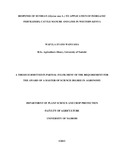| dc.description.abstract | Soybean production in Kenya has remained low, partly due to soil nutrient depletion and
degradation which have been considered serious threats to agricultural productivity. Studies have
shown that productivity of soils in western Kenya is limited by deficiency of nutrients such as
nitrogen, phosphorous and potassium a problem compounded by low organic matter and soil
acidity. Responses of soybean to nitrogen and phosphorous have been studied and documented
but little has been done on micronutrients, and also to establish the scale of macro and
micronutrient deficiencies and soybean yield response to a combination of organic and inorganic
fertilizers. Despite the major opportunities that soybean provide to human nutrition, household
income and soil N budgets in Africa, their contribution has been curtailed by several factors
including low priority given to proper nutrient management. This is because grain legumes,
soybean included, have been promoted as crops that require no fertilizer application. The
objective of the study was to evaluate the effect of inorganic fertilizer, cattle manure and lime on
the growth and yield of soybean in nutrient omission trials. Field experiments were conducted in
four sites (Eshirali, Masaba, Nyabeda and Eshisa) during the 2012 cropping seasons in Western
Kenya to determine the effect of inorganic fertilizers, cattle manure and lime on nodulation and
yield of soybean (Glycine max L.). The experiment was laid out in a randomized complete block
design with three replicates. The treatments consisted of: 1) Control-without inoculant and
fertilizer; 2) Inoculation alone; 3) NPK; 4) PK; 5) NP; 6) NK; 7) NPKSCaMgZnMo and 8)
NPKSCaMgZnMo+Manure+Lime (Seeds were inoculated with rhizobia inoculant containing
USDA-110 Rhizobium strain). Inorganic fertilizers were applied at rates of 20 kg/ha N, 30 kg/ha
P, 60 kg/ha K, 23 kg/ha S, 20 kg/ha Ca, 5 kg/ha Mg, 3 kg/ha Zn, 3 kg/ha Mo, 10 tons/ha manure
and 5 tons/ha lime. Soybean variety SB-132 was used in the trials during both the short and long
xvi
rainy seasons. Above ground biomass, nodule number, nodule dry weight, nodule mean score,
plant height, pod number, final grain yield, stover yield and 100-seed weight were determined.
Analysis of variance showed significant site, treatment and site × treatment interaction effects on
soybean above ground biomass, nodule mean score, number of nodules per plant, nodule dry
weight, plant height, number of pods per plant, 100-grain weight, grain yield and total stover
yield in both cropping seasons indicating that treatment effects were site specific. Inoculation
alone significantly increased soybean nodule mean score, nodule number and nodule dry weight
relative to control in both seasons. Application of NK had significantly lower values in most of
the studied parameters than NPK, NP and PK applications. Overall, significantly higher values
were noted in NPKSCaMgZnMo+Manure+Lime than in all the other treatments in most
parameters. Eshisa site recorded significantly higher values than all other sites in all parameters
except 100-grain weight and stover yield in the second season. The findings suggest that
combination of inorganic fertilizers, cattle manure and lime would be a feasible option for
maximizing soybean yields in western Kenya hence providing an entry point for more research
on proper nutrient management to boost soybean production in the region. | en_US |
| dc.description.department | a
Department of Psychiatry, University of Nairobi, ; bDepartment of Mental Health, School of Medicine,
Moi University, Eldoret, Kenya | |

